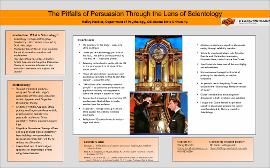| dc.contributor.advisor | Hollingsworth, Sarah | |
| dc.contributor.author | Hackler, Hailey | |
| dc.date.accessioned | 2023-04-11T14:30:01Z | |
| dc.date.available | 2023-04-11T14:30:01Z | |
| dc.date.issued | 2023-04-18 | |
| dc.identifier | oksd_URS_2023_hackler | |
| dc.identifier.citation | Hackler, H., & Hollingsworth, S. (2023, April 18). The pitfalls of persuasion through the lens of Scientology. Poster session presented at the Oklahoma State University Undergraduate Research Symposium, Stillwater, OK. | |
| dc.identifier.uri | https://hdl.handle.net/11244/337347 | |
| dc.description.abstract | No one ever expects to join a cult. Further, no one wants to join a cult. High control groups know this, and they use it to manipulate all kinds of unsuspecting people. Scientology is a cult and its various leaders have mastered the tactics of deception, coercion, and exploitation. How can one organization alone deceive so many people? Scientology began with L. Ron Hubbard; his science fiction/fantasy novels are the basis for the doctrines in this high control group. After his passing, the younger and eager David Miscavige happily took Hubbard’s place as leader. The question driving this research is: How does scientology leader David Miscavige utilize Aristotle’s artistic appeals and cognitive dissonance to persuade so many followers to join, maintain commitment, and support the church? I will argue that he does this by creating large-scale, extravagant settings for his speeches and appeals to his audience using Aristotle’s proofs – ethos, pathos, and logos. I also claim that he utilizes beloved celebrities like Tom Cruise in an effort to bring some credibility to the organization which triggers an intense state of cognitive dissonance for members and potential new members. To support my claim, I rely on the method of rhetorical criticism to review his recorded speeches and closely analyze his words, behaviors, and the overall setting. According to Hart, Daughton and LaValley, “rhetorical criticism is the business of identifying rhetoric’s complications and unpacking them thoughtfully” (2018, p. 26). The topic of scientology is complicated, so I will break down the persuasive elements and look at them from different angles. First, I will give a more detailed background of scientology and what their supposed goals are. Next, I will describe the two theories I am using to investigate this area of persuasion which are Aristotle’s Artistic Appeals and Cognitive Dissonance Theory. I will then closely examine one of Miscavige’s speeches that exhibit both theories of persuasion. Lastly, I will close with some educated conclusions drawn from my analysis and research on this topic. | |
| dc.format | application/pdf | |
| dc.language | en_US | |
| dc.publisher | Oklahoma State University | |
| dc.rights | In the Oklahoma State University Library's institutional repository this paper is made available through the open access principles and the terms of agreement/consent between the author(s) and the publisher. The permission policy on the use, reproduction or distribution of the article falls under fair use for educational, scholarship, and research purposes. Contact Digital Resources and Discovery Services at lib-dls@okstate.edu or 405-744-9161 for further information. | |
| dc.title | Pitfalls of persuasion through the lens of Scientology | |
| osu.filename | oksd_URS_2023_hackler.pdf | |
| dc.description.department | Psychology | |
| dc.type.genre | Poster | |
| dc.type.material | Text | |
| dc.type.material | Image | |
| dc.subject.keywords | scientology | |
| dc.subject.keywords | rhetorical analysis | |
| dc.subject.keywords | Aristotelian rhetoric | |
| dc.subject.keywords | cognitive dissonance theory | |
